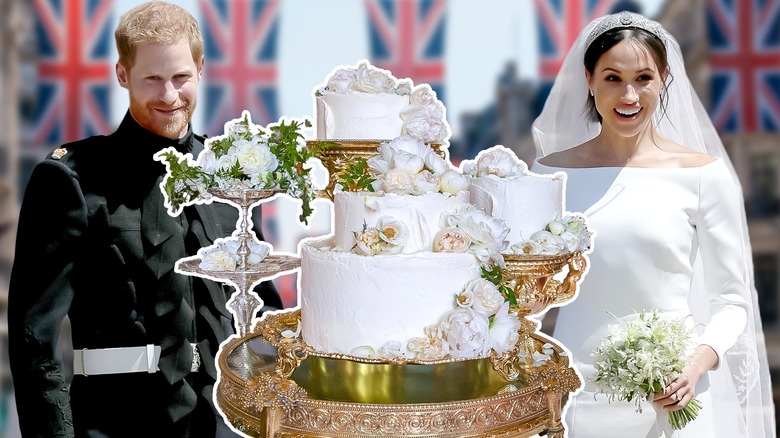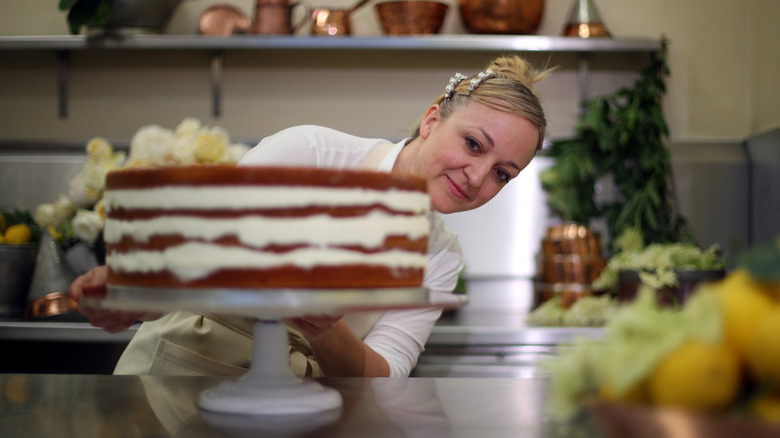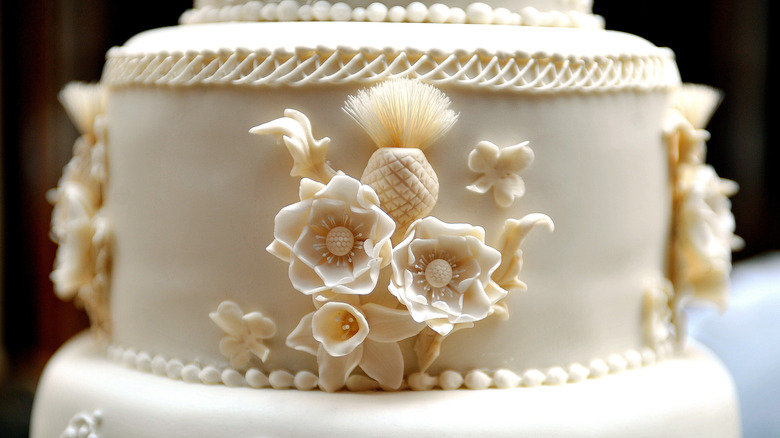The Extravagant Details Behind Prince Harry And Meghan Markle's Wedding Cake
Royal weddings are not only a celebration but a demonstration of the very best goods and services that money can buy. So when Prince Harry and Meghan Markle tied the knot in May 2018 — with an estimated 1.9 billion people worldwide coming along for the ride — you can bet they celebrated with the crème de la crème of wedding cakes (one that, according to CBS News, potentially cost more than $70,000 to make!). This incredibly special task was entrusted to London-based pastry chef and food writer Claire Ptak, who hails from California and was once interviewed by the Duchess of Sussex for her now defunct lifestyle blog, "The Tig," prior to Meghan meeting Harry. Ptak runs a boutique bakery in Hackney called Violet, which is well known for its beautiful sponge cakes which are made from high-quality organic ingredients.
Naturally, then, this was exactly what the royal couple opted for on their big day. Forgoing the rich fruitcake typically served at British royal family weddings (a tradition that has been upheld since Queen Victoria's nuptials all the way back in 1840), they instead chose a light and zesty lemon sponge cake with elderflower syrup, lemon curd, and elderflower Swiss meringue buttercream, presented as three separate pieces (two single-tiered cakes, and one two-tiered cake), which Ptak and a team of 10 skilled bakers assembled inside the hallowed kitchens at Buckingham Palace no less.
Breaking down all the delicious little details
Suffice it to say that creating a cake for 600 people (the number of guests who attended Meghan Markle and Prince Harry's lunchtime reception) was no easy feat. Claire Ptak and her team used 200 lemons sourced from the Amalfi Coast of Italy, 500 organic eggs, and approximately 45 pounds each of butter, sugar, and flour to create the delectable confection. There were also 10 bottles of elderflower syrup involved, which held special significance for the couple. The flowers used to produce this sweet liquid (officially called Sandringham Elderflower Cordial) came from Queen Elizabeth II's private garden at her Sandringham estate, where the syrup itself was also made, using a recipe created especially for the occasion.
The syrup was used to soak the cakes, and also swirled through the Swiss meringue buttercream with which they were filled and decorated. Combined with the lemon, this made for a fitting flavor choice at the Sussexes' springtime nuptials. The finishing touch came in the form of 150 fresh flowers, specifically neutral-colored roses and peonies, the latter of which is Meghan's all-time favorite bloom, according to the BBC. The stunning cakes were then displayed on intricate gilt cake stands once again sourced from the royal family's personal collection.
How other royal wedding cakes compare
While Meghan Markle and Prince Harry's wedding cake was certainly extravagant, it was actually a lot less grandiose than those typically enjoyed at royal weddings. Queen Elizabeth II and Prince Philip's 1947 wedding cake, for example, was an incredible 9 feet tall and weighed a whopping 500 pounds. This four-tier giant was big enough to feed 2,000 guests (with enough left over to donate to charities and other worthy organizations) and lavishly decorated with silver-plated shoes holding miniature bouquets, among many other delicate items. For their lavish wedding reception in 1981, Prince (now King) Charles III and Princess Diana's main cake was slightly smaller by comparison, coming in at 5 feet tall and 255 pounds and again elaborately decorated across its four tiers; though it's important to note, it was actually accompanied by 22 smaller cakes.
This brings us to the wedding cake of Harry's older brother, William, Prince of Wales and Catherine, Princess of Wales, whose nine tiers were covered in 900 sugar paste flowers that took a team of 50 chefs five weeks to complete and lace details mirroring those of the bride's gorgeous wedding gown. So while the Duke and Duchess of Sussex's creamy confection may not take the cake for size or sheer elaborateness, its unique flavor and overall breaking from tradition certainly does (the jury's still out on the cost).


